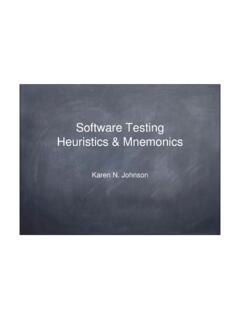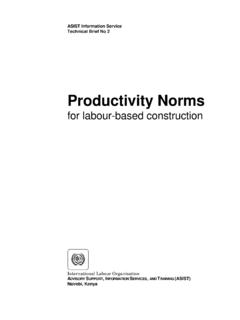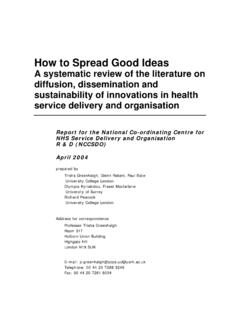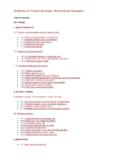Transcription of QUEST 2012 - KNJohnson Data Testing on Business ...
1 11/4/2012. data Testing on Business intelligence & data Warehouse Projects Karen N. Johnson 1. 11/4/2012. Construct of a data Warehouse A brief look at core components of a warehouse. From the left, these three boxes represent the source data that is brought into the warehouse. Next there is often a staging environment. And then finally data is loaded from Staging to the data warehouse. Users typically do not access a warehouse directly but instead access data through non- updatable views. data Testing on Business intelligence / data Warehouse Projects Karen N. Johnson, 2012. 2. 11/4/2012. ETL. ETL: a workflow process used when transferring data from one system to another, specifically moving data to a data warehouse.
2 Typically used to describe the process of acquiring source system data , manipulating it based on the data and Business rules, then populating a data warehouse.. Source: The data Asset, by Tony Fisher data Testing on Business intelligence / data Warehouse Projects Karen N. Johnson, 2012. 3. 11/4/2012. The E of ETL. data Extraction What data ? Not all the data from a source is brought into a warehouse. What's extracted? What's not extracted? What parameters? Are there time boundaries around the data selected? Other boundaries? What about the quality of existing production data ? When we pull or extract existing data we find mistakes of the past.
3 What are the Business rules of the data ? When we understand the rules around each data element, then we can plan the boundary conditions to test. data Testing on Business intelligence / data Warehouse Projects Karen N. Johnson, 2012. 4. 11/4/2012. The T of ETL. data Transformation How is data is being altered? What Business rules does that data need to adhere to? Are the data transformations custom or out of the box . transformations from say, Microsoft's BI SSIS? data Testing on Business intelligence / data Warehouse Projects Karen N. Johnson, 2012. 5. 11/4/2012. The L of ETL. data Loading The initial loading of a data warehouse begs the following questions: Is all the data there?
4 How can we be certain? What about performance? What about security, access and permissions? What about subsequent data loads? data Testing on Business intelligence / data Warehouse Projects Karen N. Johnson, 2012. 6. 11/4/2012. The OLAP cube from the Business Perspective A common example of an OLAP cube includes data for: Products Cities Time When data such as this is loaded into a warehouse, Business analytics can address questions such as: What are the top-selling products in each region over the past 12months? data Testing on Business intelligence / data Warehouse Projects Karen N. Johnson, 2012. 7. 11/4/2012. The OLAP cube from the End User Perspective The end users first contact with the data from the data warehouse is often a report or a dashboard.
5 If the data on the reports or dashboard is not accurate, the entire BI project can be at risk if the users lose confidence in the data . data Testing on Business intelligence / data Warehouse Projects Karen N. Johnson, 2012. 8. 11/4/2012. The OLAP cube from the Tester's Perspective data reconciliation is the term often used to refer to the process of confirming the data in a warehouse has been loaded completely and accurately. Determining what is complete and what is accurate is necessary and may not be obvious. data Testing on Business intelligence / data Warehouse Projects Karen N. Johnson, 2012. 9. 11/4/2012. Testing data Reconciliation As is often the case in Testing , there are more questions than answers at the start of the Testing process.
6 How do we know all the data is loaded? Why can't we use SQL counts to confirm loading? Why can't we test all the data ? Why is some data from production outside of the Business rules and the application rules? Fully understanding the questions and potential issues is a good start for Testing . On one BI project, I started by discovering the data flow; every step and every process the data moved through. data Testing on Business intelligence / data Warehouse Projects Karen N. Johnson, 2012. 10. 11/4/2012. Instead of SQL counts At the onset, it would seem that data loading could be reconciled by counting. 100,000 rows get extracted, 100,000 rows get loaded, right?
7 Because of data transformations and stored procedures straight counting may not work. What are alternative methods? Trolling production records to match test conditions and hand verifying those rows through the process. Trolling refers to what is more properly known as data profiling. Using SMEs to identify where the ugly data is and verifying those specific rows of data . Building test data that tests Business rules and data transformations in both positive (confirming) and negative (challenging) ways. Harvesting all three of these methods to build and fortify a rigorous test data set. Advocate for error logging as well as automated unit tests.
8 Don't forget to explain the rigor behind this process to the Business users. data Testing on Business intelligence / data Warehouse Projects Karen N. Johnson, 2012. 11. 11/4/2012. Source to Target Mapping Where is the data is coming from? Do you understand all the attributes of the data such as data type, field length and Business rules? Where is the data being loaded what is the target? Do you understand all the attributes of the destination for the data such as the data type, format, rules, etc. The data dictionary is often where source to target mapping is documented. That dictionary is invaluable to Testing (as well as for data governance).
9 Internally selling the importance and need for the dictionary can be an uphill battle. data Testing on Business intelligence / data Warehouse Projects Karen N. Johnson, 2012. 12. 11/4/2012. Explaining data Reconciliation Testing to the Business In order for the Business to be confident of the Testing efforts, maintain details of Testing . This might include: A list of the parameters and Business rules of the data being extracted from source systems. Building data sets that challenge the parameters and rules. Maintaining and sharing those data sets for current and future Testing . Identifying the date/time of data loads from source to target used for data reconciliation.
10 data Testing on Business intelligence / data Warehouse Projects Karen N. Johnson, 2012. 13. 11/4/2012. Invisible influences on data In addition to the more obvious data transformations that take place through ETL jobs, there are other less visible processes that may alter data . Including: Stored procedures Triggers Indexes Views Permissions Batch runs Ask if these exist. Investigate what may need to be tested. data Testing on Business intelligence / data Warehouse Projects Karen N. Johnson, 2012. 14. 11/4/2012. Testing Business Rules Business rules might preventing the loading and use of specified data . Regardless of the specifics of any rule, it is not the data that has the rule, but the requirement or a restriction around the data that is set.







